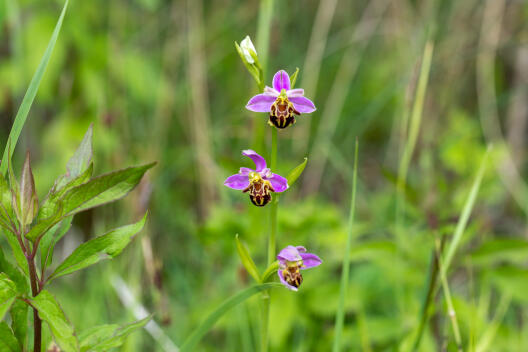

Project description

© C. Scherber The extraction of bulk raw materials such as limestone, gravel, sand and gypsum involves considerable interference with ecosystems. Nevertheless, quarrying sites often provide valuable habitats for rare animal and plant species. The project aims to conserve and promote biodiversity at quarrying sites in the construction materials industry.
Together with the Leibniz Institute for the Analysis of Biodiversity Change, a systematic biodiversity monitoring system is being established that can be applied in the corporate context of the building materials industry. Both classical and modern methods of biodiversity recording will be used. As part of the project, the species inventory of twelve quarrying sites in Germany will be investigated with the aim of recording existing populations, testing suitable monitoring methods and identifying potential for promoting biodiversity, particularly in active quarrying. Accompanying these monitoring activities, Citizen Scientists under the coordination of the NABU Germany record the biodiversity at the sites.
In the course of the project, these results will be further developed with the findings from a comprehensive industry analysis and detailed case studies into a practical biodiversity management concept for companies in the building materials industry.
Partners

© L.Pape - Project lead: Institut für ökologische Wirtschaftsforschung (IÖW), Anneli Heinrich
- Subproject Monitoring of Biodiversity in Mining Sites: Katharina Schwesig, Norbert Hölzel (Ilök)
- Further collaboration partners: Leibniz-Institut zur Analyse des Biodiversitätswandels, NABU, and several corporations of the building material industry
- Term: 2021-2024
- Funding: BMBF
Publications
- Flyer
-
Praxishandbuch: Biodiversität in Gewinnungsstätten – Management und Monitoring der Artenvielfalt (Link)
-
Schwesig, K., Zizka, V., Scherber, C., Hölzel, N. (2025): Comparing eDNA and Transect Methods for Aquatic Biodiversity Assessment in Lakes and Ponds. Molecular Ecology Resources, XX(X),[doi 10.1111/1755-0998.14060]
-
Zizka, V., Schwesig, K., Engel, N., Hölzel, N., Scherber, C. (2025): Environmental DNA supports importance of heterogeneous pond landscapes for arthropod diversity conservation. Ecosphere, XX(X), [doi 10.1002/ecs2.70171]
Theses
- Teelke Meyenburg (2023), Masterarbeit: Vegetation-Umweltbeziehungen in Abbaustätten
- Tim Richter (2024), Masterarbeit: Identifying landscape characteristics that enhance insect abundance and biodiversity: a drone-based remote sensing investigation in a limestone quarry in Lengerich, Germany
Forschungsprojekte
- Moritz Meinken und Jan Steen (2023), Poster: Diversity and habitat use of grasshoppers in mining sites
- Lennart Spreckelmeyer (2023/24), Poster: Diversity and conservation value of plant communities in active mining sites
Photos


Sphingonotus caerulans© K.Schwesig 
The GiBBS project team at the final conference in Bonn© L.Pape 
Detection of flight insects© K.Schwesig 
Excursion to a quartz sand mine© A.Sladek 
Grasshopper detection© K.Schwesig 
Limestone quarry in Rhineland-Palatinate© K.Schwesig 
Panel discussion at the final conference, October 2024© A.Sladek 
Project kickoff in Berlin, September 2022© L.Seifert 
Cattle grazing in a disused gravel pit© K.Schwesig 
Bufotes viridis© K.Schwesig 
Workshop for practical and official nature conservation© C.Wenderich


